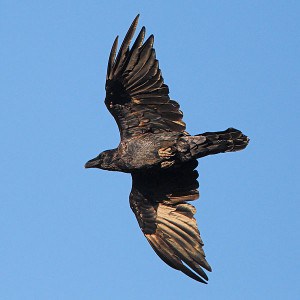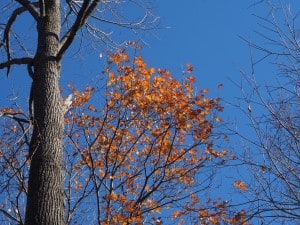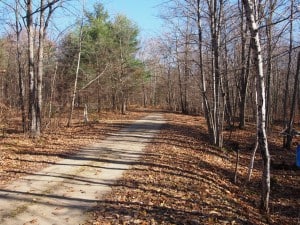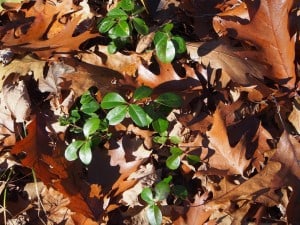We don’t often think of November as a particularly interesting month. For many, it’s simply the grey, damp interval between the dazzling leaves of October and the swirl of lights and decorations of December. For me, however, late fall has always been a favourite time of year. I love the change of pace and the sense of nature slowing down. Most migratory birds have departed and insect activity has been reduced to a few hardy moths and dragonflies. Gone are the dramatic day-to-day changes in leaf colour that enlivened the landscape just a few short weeks ago. With the veil of foliage now lifted, what stands out are nature’s fundamentals – sky, water, soil, rock and tree
With these November thoughts in mind, I took advantage of last Sunday’s beautiful weather to go for a long walk. And what better place to explore the outdoors than the Shield country of Big Gull Lake, where my wife and I were spending the weekend. It’s such a pleasure at this time of year to walk freely, unencumbered by summer’s heat and insects or winter’s snow and ice. The cool, invigorating air infuses your every step with new-found energy. But rather than focus on exercise or species’ identification, I decided to concentrate on walking mindfully and being fully aware of the simple pleasures of sight, sound and smell.
Sound
Other than the rhythm of my own footsteps on the dirt road, I was surrounded by what seemed like total silence. There was no rattle or buzz of insects and no singing birds. Man-made sounds, too, were absent. No chain saws, no ATVs, and no outboard motors. But I soon realized that this November day did indeed have a voice; its voice was the wind. And it wasn’t one wind but many: the roar of high-altitude gusts that sent clouds scurrying across the sky, the murmur of softer breezes in the pine boughs overhead and especially the constant crackle and rustle of air rushing through the dry leaves. About the only other sounds that came my way were the croaking of a distant raven, the explosion of wings of a startled Ruffed Grouse and the loud scolding of a disgruntled Red Squirrel.
As much as I love the soundscape of the natural world, I also take pleasure in the absence of sound. The stillness of late fall somehow makes us more aware of the ancient rhythms of the land as nature settles down for winter. How rare it is anymore to ever enjoy real quiet, removed from the cacophony of man-made noise to which we’ve become so fully habituated. As Sigurd Olson, an American writer and conservationist once said: “In the end we turn to nature in a frenzied chaotic world to find silence, oneness, wholeness, and spiritual release.”
Sight
On such a spectacular sunny day, I couldn’t help but notice the special quality of the light. November light is different. It is not the harsh, mid-day glare of summer that blazes down upon us from straight above. November light comes to us aslant, casting long shadows in its course. A quick glance at the sun explains why. Even at noon, the late-fall sun is little more than half way between the horizon and the sky’s zenith.
Even though I’ve walked this road countless times, late fall always surprises me with new vistas and natural features I’ve never noticed before. With most of the leaves now fallen, the outline of distant hills and valleys seemed somehow different. Even the roadside woods appeared bigger and invited exploration. Where only recently there was a curtain of greenery, I could now make out granite ridges, scattered erratics (huge stones left behind by the glaciers), newly fallen trees and even some woodland ponds that I’d never seen before. But more than anything, the forest interior was mostly a play of dark tree trunks, long shadows and fallen leaves. What really caught my attention, however, was how the angled November sunshine magnified the oak leaves’ natural glaze and made them sparkle like diamonds. Even the individual leaves on the road’s surface blazed like tiny flares.
Scattered about the forest floor, I also noticed numerous oases of greenery. Some were patches of green moss on a rock or log, but there were also clumps of evergreen ferns like Wood Fern and Rock Polypody, club-mosses such as Ground-pine and Ground-cedar, and evergreen wildflowers like Hepatica and Wintergreen. It was almost as if these plants were saying: “We don’t want anything to do with this change of season!”
I was also reminded of just how common oaks are in the Kaladar area. Since most of the oaks still retained some of their leaves, they stood out clearly against the other deciduous trees, most of which were bare. Conifers, too, were more conspicuous than usual. Looking towards the horizon, I could see numerous White Pines towering above the other trees and clearly displaying their iconic wing-like branches. Along the edges of wetlands, spire-shaped Balsam Firs, columnar White Spruce and smoky-gold Tamaracks were all easy to spot.
The roadside, too, provided items of interest, including a few remnants of fall colour. A small display of pinks, reds and burgundies came courtesy of the remaining leaves on the Maple-leaved Viburnums, Common Blackberries and the seedlings of Red Oak. I also noticed a handful of asters still clinging to their mauve petals. Much more common, though, was the huge variety of seeds such as those of the milkweed spilling from half-open pods and the fluffy grey seed heads of the goldenrods. The promise of spring wasn’t hard to find, either. The numerous young maples and cherries growing along the edge of the road were covered with fully-formed buds, just waiting for April rains and warmth to swell and open.
Smell
In much the same way as November is not a time of sounds, nor is it a time of smells. The cool temperatures of this particular morning had even neutralized the lovely fragrance of the fallen leaves. As I returned to the cottage, however, the faint smell of wood smoke immediately caught my attention and had me looking forward to the warmth of the fire and a cup of coffee.
When we arrived back in Peterborough in late afternoon, it was already getting dark. With the return to Standard time, dusk comes early at this time of year. But short days, too, are something I love. In my mind’s eye, I see the northern hemisphere tilted sharply away from the sun. I imagine the sun’s rays striking our part of the world diagonally, scattering themselves over a much larger area than in summer and creating far less warming. Short, cool and reduced to nature’s fundamentals, these November days are no less than a palpable reminder of the change of season – and seasonal change is what makes living in the Kawarthas so wonderful.




